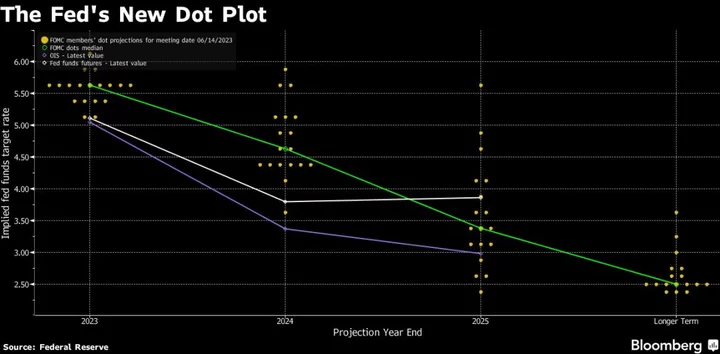Federal Reserve Chair Jerome Powell said at least two interest-rate increases are likely necessary this year to bring the inflation rate down to the US central bank’s 2% target.
“A strong majority of committee participants expect that it will be appropriate to raise interest rates two or more times by the end of the year,” Powell said Thursday, referencing the policy-setting Federal Open Market Committee. “Inflation pressures continue to run high, and the process of getting inflation back down to 2% has a long way to go.”
In remarks prepared for a conference in Madrid at the Bank of Spain, Powell repeated comments he’s made in the two weeks since the Fed’s last meeting, where policymakers held rates steady for the first time since early 2022. Officials opted to pause then, while at the same time signaling two more rate increases may be appropriate this year, to better assess how both policy and banking-sector stresses are impacting the economy.
“We see the effects of our policy tightening on demand in the most interest rate-sensitive sectors of the economy, particularly housing and investment,” Powell said. “It will take time, however, for the full effects of monetary restraint to be realized, especially on inflation.”
The Fed raised rates at a fast clip last year, including four consecutive three-quarter point hikes, from near zero in March 2022. Officials started slowing the pace in December and delivered 25-basis-point hikes in each of the first three meetings of this year. They held rates in a range of 5% to 5.25% at their June 13-14 meeting.
While overall inflation has cooled significantly from a peak of 9.1% a year ago, measures stripping out the more volatile food and energy prices have come down much more slowly. Powell and his colleagues have pointed to the “stickiness” in core inflation as something that they’re closely monitoring.
Powell said Thursday regulators are committed to learning lessons from the failure of Silicon Valley Bank and two other US lenders. While the largest banks remain well capitalized and safe, and the size diversity of the country’s banking system should be preserved, more may need to be done in overseeing mid-size banks and the nonbank sector.
“These events suggest a need to strengthen our supervision and regulation of institutions of the size of SVB,” Powell said. “I look forward to evaluating proposals for such changes and implementing them where appropriate.”
Vice Chair for Supervision Michael Barr is in the midst of a review of bank regulation and is expected to propose changes soon.
The remarks echoed those he made in his semiannual testimony before Congress last week.
The bank stress may lead to a further tightening of credit conditions, adding to what the Fed has itself induced through its rate increases, but just how much remains uncertain, Powell said.
He acknowledged that while the labor market remains tight, some signs are emerging that supply and demand are coming into better balance.

